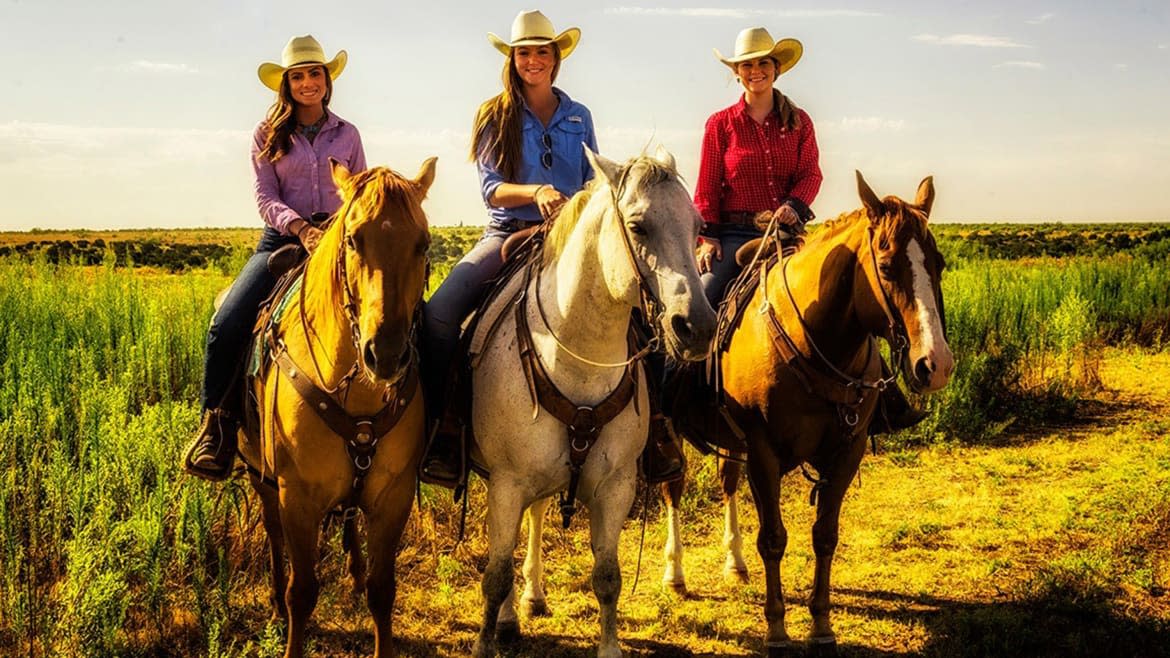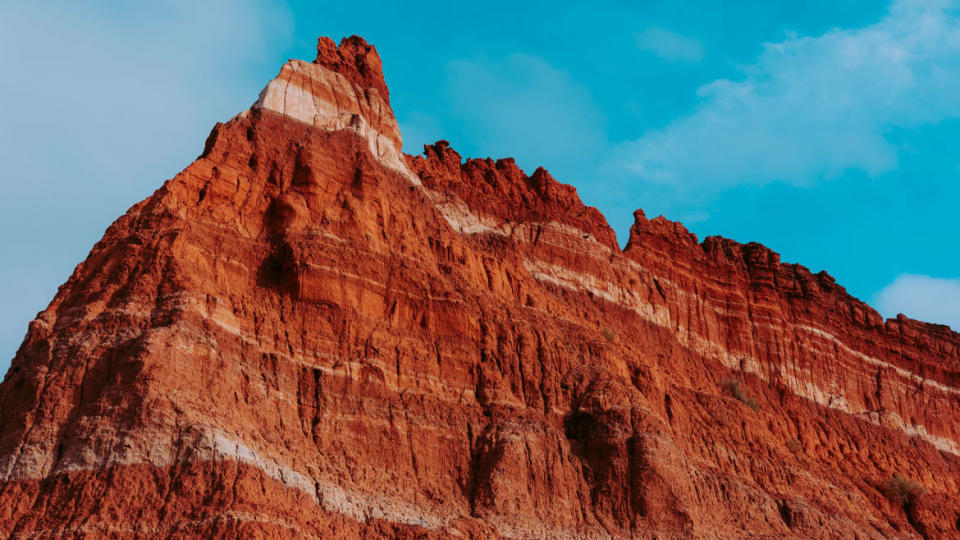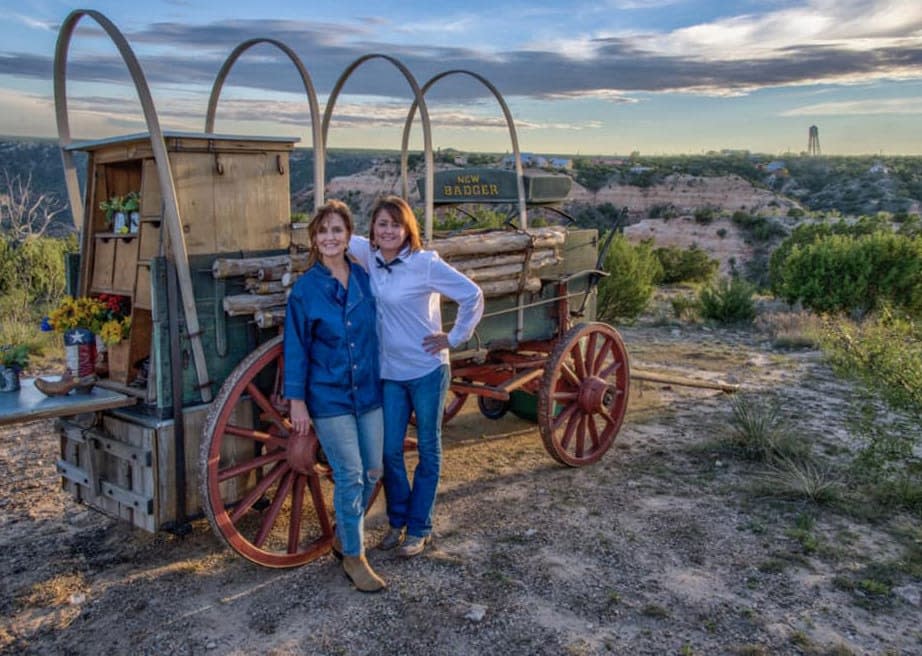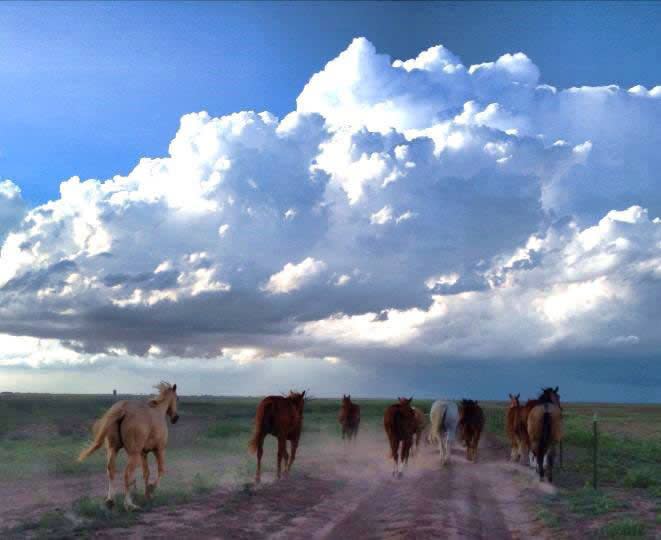Texas’ Best-Kept Secret: The Second-Largest Canyon in the U.S.

“The history of this area is game changing,” Phyllis Nickum says as I stare into Palo Duro Canyon, a 120-mile-long chasm slicing through the level landscape of the Texas panhandle just south of Amarillo. Palo Duro marks the southern border of Nickum’s Los Cedros Ranch, a 3,000-acre spread where she raises cattle, horses, and harvests wheat and water. It’s also home to “Cowgirls and Cowboys in the West,” the ranch’s tourist arm, which celebrates Western heritage through history on horseback tours, eco-tourism, and chuckwagon events complete with singing cowboys.
As I inch closer to the canyon’s lip, Nickum adds, “The thing you don’t realize, these ledges, the wind erodes it underneath.” Where I’m standing, it’s nearly a thousand-foot drop to the floor below. She steps back. “I don’t like heights.”
Six flags have flown over Texas: Spanish, French, Mexican, the Republic of Texas, Confederate, Texas State, and the United States of America. Territory was claimed, only to be knocked down by the native tribes of West Texas—none more ruthless than the Comanche, a tribe made up of about 13 bands, one of which was the Quahadi, the most lethal of all.
Palo Duro Canyon was the peaceful winter home of the Quahadi. “Here, they never had to defend anything,“ Nickum shouts. It’s difficult to hear above the wind that is parting our hair in all directions. “When temperatures started to fall, the women would gather up the families, take down the tipis, herd the horses, and make the trek from wherever they were to Palo Duro. The temperature stays 15 degrees warmer down there.”
It’s an unseasonably cold day when I join Nickum for a tour of her ranch and a lesson in the violent history of the surrounding region. I’m freezing my ass off. I didn’t pack for this. I’d thought of Amarillo as varying degrees of hot year round. Yet here it is almost summer, and a snowstorm is predicted to hit later in the day. So, no horses for us. We take her truck.
The harsh climate was just one of several hazards that kept settlers away from this nearly treeless, windswept corner of the Great Plains. “The white man—no one ever came here,” Nickum says. And if wild weather vacillations and an endless, intractable landscape of dirt and grass weren’t enough to keep settlers from pressing beyond the trees and rivers of Central Texas, the word “Comanche” certainly was. Those who encroached upon the canyon met legendarily violent fates: Captives were skinned, scalped, spit-roasted, dismembered, plugged with arrows, and fed their own genitals. That’s why the white man didn’t discover Palo Duro until 1874.
“The Comanches were badass!” Nickum tells me. “The most powerful Indian tribe in American history. And it’s all because of the horse.”
Native Americans Invented Our Gun Culture—and Yes, We Stole That, Too
There were no horses in the Americas until 1541, when the Spanish conquistadors blew into what is now New Mexico in search of the Fountain of Youth and the Seven Cities of Gold. They brought with them the first horses to grace American soil. That was the real game changer. Natives had never seen a presence so commanding as a Spaniard in chainmail astride a horse. Hellbent on spreading Catholicism, the Spanish enslaved the Pueblo. Farming Indians known for their boxy adobe villages, the Pueblo tended their masters’ land and horses but were forbidden to ride lest they rise up against them. But they did that anyway. After the Pueblo drove the Spanish out, they ate a few horses and traded or loosed the rest into the desert before returning to their settlements to farm.
Rumors about the horse had circulated throughout the desert states and into Wyoming. Other tribes quickly saw the advantages of owning horses, and none more so than the fearsome tribe the Ute called “Comanche,” which means, simply but succinctly, “enemy to all.”
The Comanche were warring nomads, and the first tribe to breed horses, which they sold to other tribes. A Comanche chief might have hundreds of horses, while the highest ranking members of other tribes had 20 or so—and those were probably Comanche-bred. The disparity in wealth and power between the Comanche and other tribes was ridiculous. And they did something very different from all the other Native Americans, or anyone at that time in history: They stayed mounted when they fought. An indomitable force of braves charged into battle standing on horseback or riding sideways along the horse’s torso, using its body as a shield as they launched arrows into their tribal enemies and the white settlers who ventured too close to “Comancheria.”
For more than 40 years after the Indian Removal Act of 1830, the Sioux in the northern plains and the Comanche down south successfully fought off every effort to invade their territories. Even the cattle drives bypassed the area. But after the Civil War, as the railroads began to connect the whole country and as more and more ranchers pressed west, it was time to settle the final frontier. “The reason it took the government so long is because the Sioux and the Comanche were horse Indians,” Nickum says. “And they couldn’t catch them. Literally, they could not catch them.”
Today, like all days except Thanksgiving, Christmas Eve, and Christmas Day, tour buses pull into Los Cedros ranch and disgorge groups looking for a taste of the frontier life offered by “Cowgirls and Cowboys of the West.” Two cowgirls on horseback, flying the flags of Texas and the United States, welcome tourists eager to ride one of Nickum’s beautiful horses—descendants of those first Spanish mounts. A cowboy guitarist serenades guests as they eat a chuckwagon meal. “Cookie” isn’t ladling stew and beans into tin plates from the back of the chuckwagon. There’s breakfast casserole and brisket filling the stomachs of visitors before they ride off to see Nickum’s exclusive view of the canyon’s natural formations: Fortress Cliff, Indian Slides, the Lighthouse, the domed Capitol Peak.

Layers of sedentary rock on the walls of the Palo Duro Canyon State Park in Canyon, Texas.
At the base of the “Spanish skirts,” where striped rock formations widen into dramatic flares, the 1,600-seat Pioneer Amphitheater appears as though carved out of red sandstone. Performances of Texas, the outdoor historical musical, run summer evenings between June and August. Audiences looking skyward can see the Los Cedros water-harvesting tanks. “Here in West Texas, there’s hardly any rain or water,” Nickum says. “There’s only one natural lake in the whole state of Texas, and that is Caddo Lake. All the other lakes you see are man-made. Out here, we don’t make lakes. We just keep the land as it is. For an eco-enthusiast, it’s perfect.”
A few grazing horses raise their heads to greet us as the pageant of muscular geldings slowly rounds the path hugging the northern end of the canyon. As they get closer, it’s difficult not to bow to the majesty of the mustang, especially knowing the lexicon for coat descriptions—flea-bitten gray, black-skinned white, toasted sorrel, splotched appaloosa—were gifts from the Comanche who had more words for horse than pretty much anything else. Nickum smooths the corner of one horse’s eye. “He’s got sandman boogers in his eyeballs. We had so much wind the other day.” I meet Hero, christened on 9/11. And Boon, “the grandson of a very famous quarter horse named Peptoboonsmal.” A golden palomino noses in for some love.
Nickum runs her fingers through the rust coat of Simply Red. “They’re shedding their coats. We need to keep it one more day, though.” There is a buckskin looking funny with his ears pushed back. “The Paint back there is pretty much a standard for Indians.”
“Weather permitting, we ride,” she says. “Most of our guests have never been on a horse, so we teach them.” Once tourists are comfortable in the saddle, the group rides posse-style (side-by-side rather than nose-to-tail) for a close-up look at Texas’ best kept secret: the second largest canyon in the U.S. Like the Grand Canyon, Palo Duro defies attempts to describe it in words or capture it in photographs. There is simply too much of it to take in.
Riding across her ranch, Nickum tells the story Texas doesn’t—the oral history and plight of the Comanche Indian: “the best horsemen and horsewomen to ever ride the face of the earth.”
Their invulnerability, however, was flawed. The Comanche depended on two things: the horse and the buffalo. “Without the horse, the Comanche was just another nomadic Indian hunting afoot.” Without the buffalo, they would starve.
White people didn’t discover Palo Duro until Sept. 27, 1874 when Col. Ranald Mackenzie caught up with the Quahadi after four years of pursuit. “They weren’t well known,” Nickum says, “because they kept to themselves.” They refused to interact or trade with the white man, and as a result had avoided plagues, treaties, and reservations.
Mackenzie was hunting the last and most formidable Quahadi chief, Quanah (“odorous”), who also happened to be half white—a common enough mix as both sides held captives for ransom and sin. But no half-breed had ascended to chief before Quanah Parker.
Mackenzie’s prey was the son of Cynthia Ann Parker, kidnapped when she was 9 in the infamous Comanche raid on Fort Parker in 1836. Earlier that year, the Parker clan—16 men, eight women, and nine children—had laid claim to 18,000 acres of land in the newly established Republic of Texas. Basically, they owned what is now Mexia, Texas, and what was then absolutely nothing. Granting land in the Republic wasn’t about settling it so as much as it was about buffering the Mexicans from the Comanche. But settlers took the bait.
Sitting on the edge of the plains, a smidge too close to Comancheria, Fort Parker lay too far west to receive any protection from lawmen or the Army. This does not seem to have overly concerned the unwary Parkers: the gate of their fort stood wide open the day a band of more than 100 Comanches rode in, slaughtered most of the family in a monstrous bloody attack, and took six captives, including Cynthia Ann. Renamed Nadua (“foundling”) by her captors, she shed her native English and was adopted by an Indian couple—Comanche fertility rates were low, and the tribe relied on young female captives to fill their ranks. While most were enslaved, Cynthia Ann eventually married Chief Peta Nocona, with whom she had a daughter, Prairie Flower, and two sons, Quanah and Peanuts.
After living with the Comanche for more than 20 years, Parker and her daughter were recaptured by Texas Rangers at the Battle of Pease River in 1860 where her husband, Peta Nocona, was allegedly killed and scalped. Quanah and Peanuts escaped, but Cynthia Ann never saw them again. Although considered “redeemed” by her white neighbors, she was never comfortable in white society and tried at least once to run away and rejoin her Comanche family.
Cynthia Ann was often showcased as “the White Squaw” to gawking onlookers—a sideshow curiosity, because she wanted to return to Comanche life with her missing sons. Prairie Flower faired better. She had been taken to the Texas cities as an infant and had lived her short life in civilization on the prairie outside Comancheria. In 1864, Prairie Flower died, leaving her mother widowed and childless. Cynthia Ann became so despondent that she refused to eat or drink.
Cynthia Ann Parker died in 1871, the same year President Ulysses S. Grant gave the order to end the “Indian problem” by any means necessary. The best way to eradicate Indians was to eliminate their subsistence—the buffalo. While the horse wasn’t indigenous to America, the buffalo was. Before the 1870s, more than 50 million buffalo roamed the Great Plains.
“The buffalo was everything” for the Comanche, Nickum says. “Buffalo hides gave them the leather for tipis. It was food. The bones were used for weaponry and tools, the hides were used for blankets and warmth.” It was durable enough to sustain the winds, offer shade, and retain heat. The dung fueled fires, and bows were made of sinew. The animals were of little value to settlers. Destroying the herds was simply a way to starve the Indians. Buffalo hunting became one of the largest and most shameful mammal exterminations in human history.
While this slaughter was taking place, Chief Quanah and his braves quietly stalked Col. Mackenzie, even as he and his calvary and two Native scouts—642 men in total—hunted the Quahadis. This cat-and-mouse game dragged on for more than three years, largely because the whites were so inept. The American settlers and cavalry knew nothing of stealth. They traveled in big groups on loud horses weighted with clanging canteens and guns. They kept yapping dogs as pets and built fires at night in places otherwise lit only by the moon and stars. They drank heavily and talked loudly. So, at night, while the white man slept, the Indians raided, often freeing, killing, or stealing their horses, including Mackenzie’s own gray pacer.

The white men tried tying their horses to large iron stakes driven into the ground. That didn’t work. They awoke to their horses stampeding with huge nails flying around. Catching hold of one wouldn’t stop a horse. The horse just kept going, dragging the man behind him. Eventually, horses were not only attached to stakes pounded into the soil but were also hobbled: front hooves bound together and tied to the opposite back hoof. With the horses disabled, it became impossible for the Indians to free them.
That fateful September day in 1874, “Mackenzie was led to a point just like this,” Nickum says, as we gaze into Palo Duro Canyon. “They don’t know exactly where it is. But, I would imagine it was close to this area, because they were coming from the east going westward.”
“When Mackenzie crested the ridge, he saw hundreds of tipis along the banks of the Prairie Dog Town fork of the Red River. He could hear children laughing. They were racing their horses the length of the canyon. He saw smoke rising from the campfires where the women were cooking. But no one saw him and his cavalry.”
Mackenzie also saw nearly 2,000 horses within the three-mile spread of the Comanche settlement inside Palo Duro. Despite the portrayal of absolute savagery, the Comanche were a jocular group of high stakes gamblers who rarely lost horse races. They passed time singing and dancing. They were wildly funny, and outfoxing the white man was campfire fodder for days. Captives write of gossipy and vain men who cut the plaits from their squaws that they wove into their own long hair. They doted on their wives and children and protected them as any white man who dealt with trespassers would. But the braves were out hunting the day Mackenzie stumbled on the Quahadi.
Elated at finally discovering the Comanche hideaway, but still enraged at being outmaneuvered for three years and maybe a little sore about his grey pacer, McKenzie stared into the Quahadis’ inner sanctum that protected them from enemies and treacherous elements. Finding the last free home of the last few thousand Indians was one thing, but finding out there was far more beauty beyond the border of Comancheria than just a flat, dusty lunarscape must have awed the Army. Suddenly, it all fell together: Indians rode into battle and quite literally disappeared into the scorched earth among grand spires and protective caves enclosed within gray, lavender, and pink banded walls. At that point, a few canyons were known to white invaders and none more magnificent than Palo Duro.
After dark, the colonel and his bluecoats slid down a precarious goat trail they’d discovered earlier in the day. Mackenzie’s soldiers were armed with repeating rifles, which gave them an immense advantage, probably the most profound advancement in war since the horse at that point. When they reached the bottom of the canyon, they opened fire. When the Quahadi awoke to the ambush, what few men were left in camp shielded their wives and children in defense. But they couldn’t hold up under the Army’s relentless gunfire and retreated up the walls of the canyon behind their families.
“Keep in mind, there were only women and children, maybe a few braves there, old people,” Nickum says. “They only killed a couple of Indians. But what they did next changed history.”
MacKenzie and his men set everything ablaze: food stores, drying meat, hides, tipis, weapons—every flammable object was rendered into ash.
Then the horses were herded to nearby Tule Canyon, a box canyon with towering rock walls that trapped the horses on three sides. Over the next 24 hours, MacKenzie’s men shot more than a thousand horses. The remains were left to rot, and decades later the sun-bleached bones were hauled away and ground into fertilizer—a fate they shared, ironically, with over 30 million buffalo.
“The Comanche horses were like mine. They were the best of the best. They were athletic, they were trained, they were talented,” Nickum says ruefully.
“Cowgirls and Cowboys” is only part of what goes on at Los Cedros. It is also a working ranch. Today is business as usual. “We just moved our bulls or I would take you out to see them. They’re out visiting their girlfriends, making more… hopefully heifers. Or we’ll cut ’em and turn ’em into steers. Everything out here—we cut all the men.” She punctuates her deadpan delivery with a laugh.
Before starting “Cowgirls and Cowboys in the West” with her late husband, Ronald Nickum, Phyllis Nickum moved from Seattle to Amarillo for a position as general manager and director of operations at the Ambassador Hotel. Born the daughter of a hotelier, she’d been in hospitality her entire life. Touring hotel properties with job applicants was her no-nonsense approach to hiring, I’m told. If candidates passed even a speck of dirt without picking it up, they weren’t hired. The same applies at Los Cedros.

As we drive out to the entrance of her ranch, she spies a plastic bag tumbling through the grass near one of the fences. “I’m going to get that plastic bag. I can see a plastic bag a mile away. I have a plastic bag obsession.”
She comes back with a branch of dried mesquite. “I brought you a present. They say everything in Texas has thorns—even the women. See those thorns? Anyway, this is what gives steak that great taste.”
We wind up at the entrance of Los Cedros where her ranch hand is waiting. He’s wearing a starched shirt tucked into his jeans, George Strait style.
As she climbs down, she explains: “Out here at the ranch, everything is dangerous, so you always try to do things in pairs, if you can.” No lone rangers out here. “My husband got headbutted by a bull and was in ICU for three weeks for a brain bleed. And it was on that coldest day. He ended up being in ICU three times over that accident. And I wasn’t with him. We’d had a real icy day. We lived in town at that time.”
Nickum and her ranch hand lower the United States flag from the pole and ceremoniously fold it into the proper triangle that displays the white stars against the blue background on both sides. They do the same with the Texas flag. Both are placed in the backseat and later given to the Boy Scouts. It’s no time out of their day to respect the flags.
Editor's Note: This is the latest installment of our series on underrated destinations, It's Still a Big World.
Get our top stories in your inbox every day. Sign up now!
Daily Beast Membership: Beast Inside goes deeper on the stories that matter to you. Learn more.

